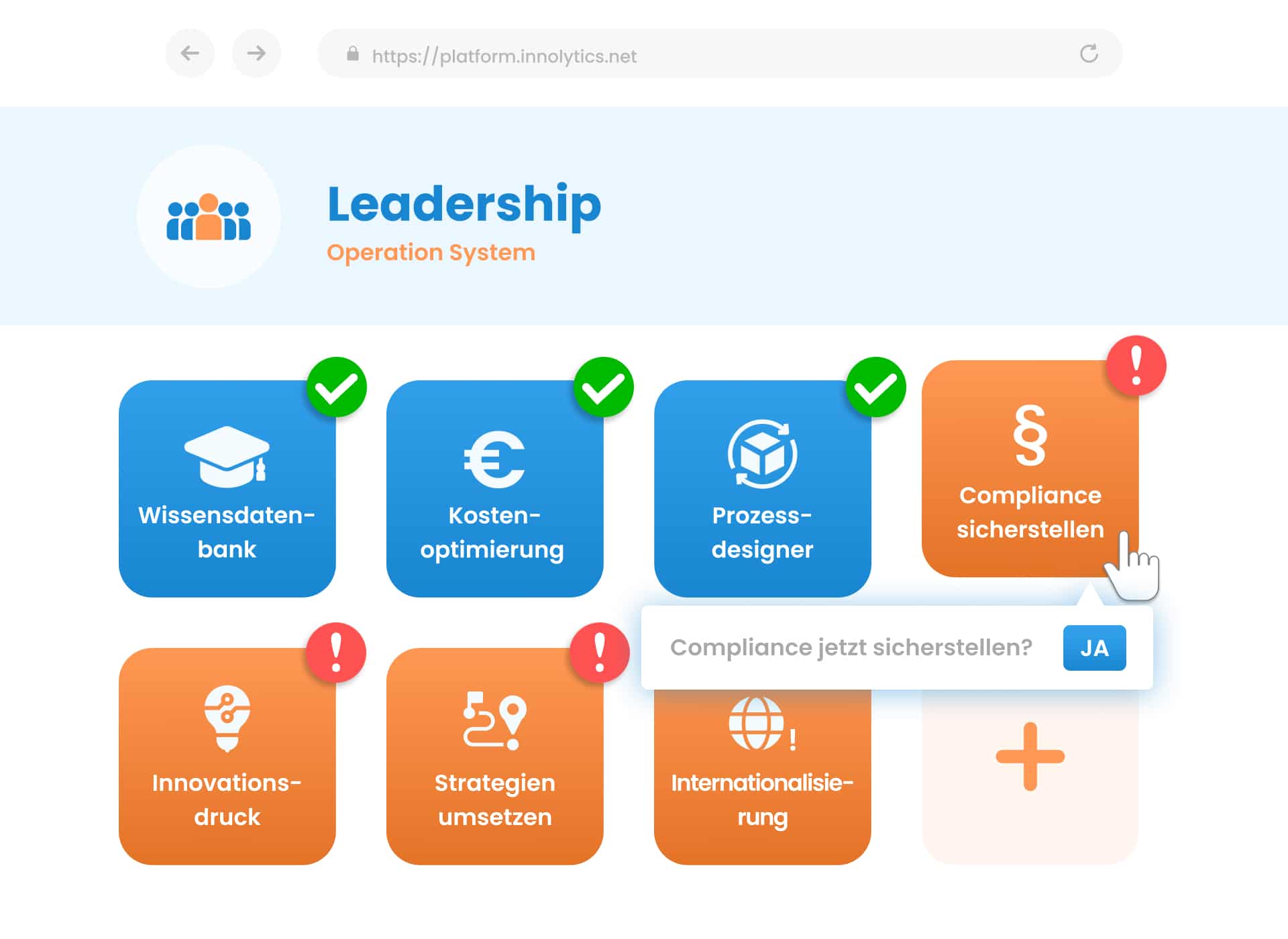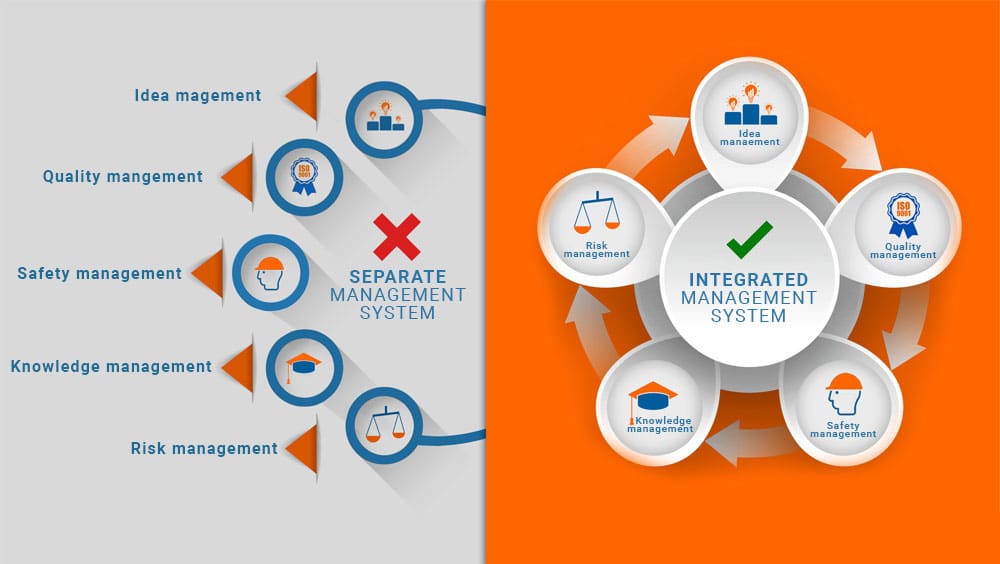What is a Management System?
A brief explanation and introduction

Definition of management system?
Management systems distinguish professional companies from those in which things happen randomly and on-demand.
Different motives underlie the introduction of management systems:
- Business causes: Companies want to improve their performance and efficiency.
- Competitive causes: Companies want to be certified to a management system (e.g., ISO 9001:2015).
- Regulatory causes: Companies need to prove that they comply with legal regulations (e.g. occupational safety).
The most well-known management systems include ISO 9001:2015, ISO 27001, and ISO 45001 for occupational safety. These management systems can be the subject of ISO certification. Other management systems include Total Quality Management, Six Sigma, and ISO 56002 for innovation management.
Many management systems are interpreted, defined, and implemented by companies themselves. These include, for example, the continuous improvement process, idea management, risk management, and knowledge management. Although there are relevant standards for this in some cases, such as ISO 31000 for risk management, in practice many companies design it themselves. In implementing a management system for ideas or knowledge, companies often tend to focus on their own needs and best practice solutions.
Management systems enable companies to manage complex cross-functional management tasks. Through clear roles, rules,d, and processes, topics such as quality, sustainability, innovation, knowledge, and occupational safety are managed in a structured way.
Learn more about the Innolytics® software for management systems now

Understand the philosophy of management systems
Why do management systems exist? What is their goal? And what is the intellectual basis? There is a rather simple philosophy behind the development of management systems: To create a mechanism that allows companies to reliably do things that are important for the company’s success, and to continuously improve in the process. For more information, read our article on the ISO 9001 philosophy.
- Management systems are tools for managing complexity. It is about setting goals, considering the framework conditions, deriving actions and measures from the goals, and reliably completing tasks through clear processes and responsibilities.
Quality management example: In order to continuously deliver high quality in all areas of a company, measures are required that affect all areas – from top management to trainees. A quality management system, therefore, deals intensively with the four phases according to the PDCA cycle: Plan, Do, Check, Act.

Plan : Corporate planning measures
Corporate activities do not arise spontaneously or as a result of individual customer requests but are carefully planned. Planning is the largest and most important part of the ISO 9001:2015 quality management system. If, for example, all core processes of a company are to be documented, this means nothing more than that the company plans what it needs for processes to achieve its goals.

Do : Execution of planned activities
Management systems are based on the philosophy that the execution of planned activities is (almost) independent of individual persons. If all necessary measures and business processes are defined, if responsible persons are named and success indicators are defined, then – according to theory – tasks will almost take care of themselves. This is not always the case in practice, but it is the ideal state that companies strive for by introducing a management system.

Check : Checking whether goals have been achieved
Management systems are based on the philosophy that everything is measurable. Has the sales department achieved its goals? This can be measured, for example, in the number of customer meetings, the closing rate, or the value of newly acquired orders. Customer satisfaction with a company’s products, offers, and services can also be measured. This is an important component of management systems: Success is not left to chance but measured.

Act : Continuous improvement
In management systems, every deviation between “target and actual” is not an error, but a deviation that can be optimized. Accordingly, continuous improvement is an important part of a management system. It is about companies asking themselves again and again, down to small detailed processes, the question: Is it running optimally?
This logic, which was explained using a quality management system as an example, can be applied to virtually all other management systems, regardless of whether they are sustainability management, energy management, risk management, or information security management. At its core, it is always about the same thing: Plan activities, execute, review metrics, and systematically improve.
You could put it another way: Once you have understood the core of a management system, you have understood 70 to 80 percent of all management systems. At ISO, this is called “High-Level Structure”.
In order to make management systems more accessible, especially for small and medium-sized companies, the organization has agreed to give its management systems basically the same structure. This makes it much easier for a company that has introduced a quality management system in accordance with ISO 9001:2015, for example, to introduce another one on the subject of sustainability, energy management, or information security.
To ensure that these management systems do not coexist, there is the concept of an integrated management system.
Management System Software
Since management systems – as described – affect practically all parts of a company, it makes little sense to have different systems running parallelly. Quality management here, information security management there, creates unnecessary effort and leads to confusion among managers and employees. Management system software are therefore becoming increasingly important. They combine several existing and new systems under one umbrella. This will be explained using an example.
Practical example
A company has been operating a successful Idea management system for years. Now it is pursuing an ISO 9001:2015 certification. The standard requires companies to implement and operate a continuous improvement system. It is now counterproductive to introduce another CIP approach in parallel to the existing idea management system. Employees would be confused: Where should my ideas go now?
Accordingly, an integrated management system allows both to be combined. The same applies, for example, to process optimization or knowledge management tools already introduced in the company: It makes little sense to set up a second management system here.
An integrated management system, therefore, combines existing internal management systems as well as external management systems (e.g. according to ISO 9001, ISO 14001, or ISO 27001) in an integrated management system. The existing idea management is now used to generate suggestions for leaner procedures and processes (quality management), for sustainability (ISO 14001), or for increasing information security (ISO 27001) and to implement corresponding measures.

Management system software reduce the complexity involved in introducing and operating a management system. This is because – as has already been described in this text – management systems serve to reduce complexity and make it controllable – not to build up new complexity in an already complex business world.
Companies that introduce one or more management systems (e.g., as an integrated management system) are in a much better position to achieve their goals than those that leave this to chance.